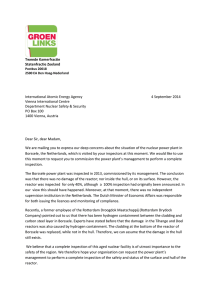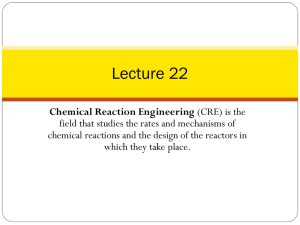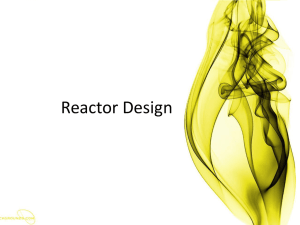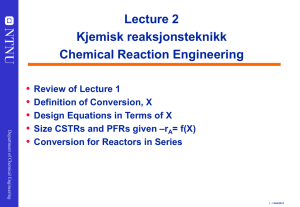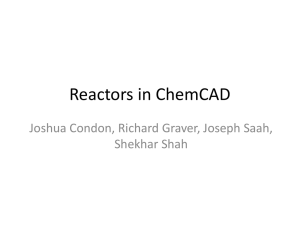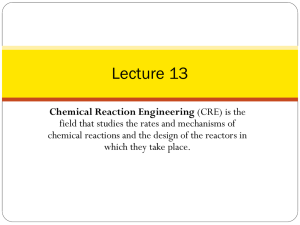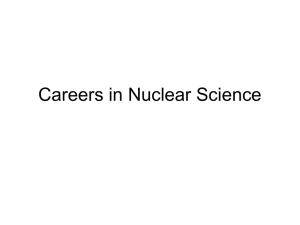13-L1-L2-Reactor Design - Department of Chemical Engineering
advertisement
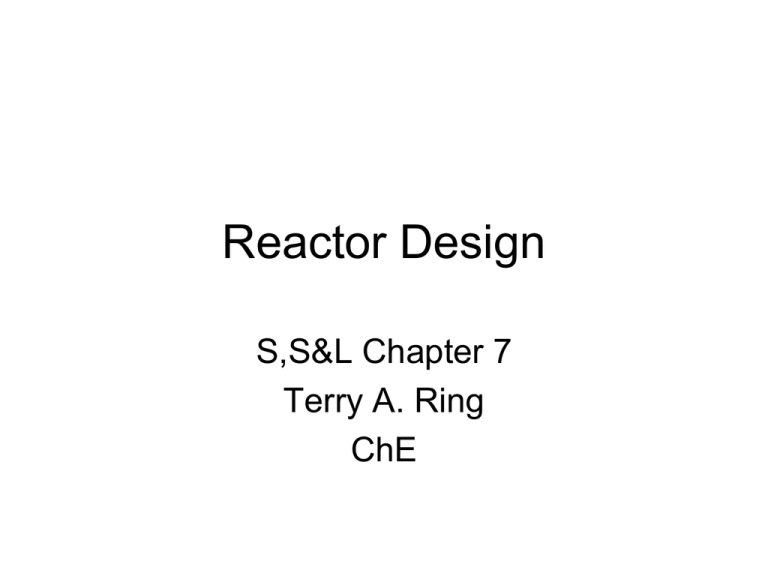
Reactor Design S,S&L Chapter 7 Terry A. Ring ChE Reactor Types • Ideal – PFR – CSTR • Real – Unique design geometries and therefore RTD – Multiphase – Various regimes of momentum, mass and heat transfer Reactor Cost • Reactor is – PRF • Pressure vessel – CSTR • Storage tank with mixer • Pressure vessel – Hydrostatic head gives the pressure to design for Reactor Cost • PFR – Reactor Volume (various L and D) from reactor kinetics – hoop-stress formula for wall thickness: PR tc SE 0.6 P t= vessel wall thickness, in. P= design pressure difference between inside and outside of vessel, psig R= inside radius of steel vessel, in. S= maximum allowable stress for the steel. E= joint efficiency (≈0.9) tc=corrosion allowance = 0.125 in. t – • • • • • • Reactor Cost • Pressure Vessel – Material of Construction gives ρmetal – Mass of vessel = ρmetal (VC+2VHead) • Vc = πDL • VHead – from tables that are based upon D – Cp= FMCv(W) Reactors in Process Simulators • Stoichiometric Model – Specify reactant conversion and extents of reaction for one or more reactions • Two Models for multiple phases in chemical equilibrium • Kinetic model for a CSTR Used in early stages of design • Kinetic model for a PFR • Custom-made models (UDF) Kinetic Reactors - CSTR & PFR • Used to Size the Reactor • Used to determine the reactor dynamics • Reaction Kinetics rj dC j dt C k (T ) Ci i i 1 EA k (T ) ko exp( /) RT PFR – no backmixing • Used to Size the Reactor Xk dX V Fko rk 0 • Space Time = Vol./Q • Outlet Conversion is used for flow sheet mass and heat balances CSTR – complete backmixing • Used to Size the Reactor Fko X k V rk • Outlet Conversion is used for flow sheet mass and heat balances Review : Catalytic Reactors – Brief Introduction Major Steps B A Bulk Fluid CAb 7 . Diffusion of products from pore mouth to bulk 1. External Diffusion Rate = kC(CAb – CAS) External Surface of Catalyst Pellet CAs 6 . Diffusion of products from interior to pore mouth 2. Defined by an Effectiveness Factor Internal Surface of Catalyst Pellet 3. Surface Adsorption A + S <-> A.S Catalyst Surface A B 4. Surface Reaction 5. Surface Desorption B. S <-> B + S Catalytic Reactors • Various Mechanisms depending on rate limiting step • Surface Reaction Limiting • Surface Adsorption Limiting • Surface Desorption Limiting • Combinations – Langmuir-Hinschelwood Mechanism (SR Limiting) • H2 + C7H8 (T) CH4 + C6H6(B) rT k pT p H 2 1 1.39 p B 1.04 pT Catalytic Reactors – Implications on design 1. What effects do the particle diameter and the fluid velocity above the catalyst surface play? 2. What is the effect of particle diameter on pore diffusion ? 3. How the surface adsorption and surface desorption influence the rate law? 4. Whether the surface reaction occurs by a single-site/dual –site / reaction between adsorbed molecule and molecular gas? 5. How does the reaction heat generated get dissipated by reactor design? Enzyme Catalysis • Enzyme Kinetics rs k1k3CH 2OCE CS k1CS k 2 k3CH 2O • S= substrate (reactant) • E= Enzyme (catalyst) Problems • Managing Heat effects • Optimization – Make the most product from the least reactant Optimization of Desired Product • Reaction Networks – Maximize yield, • moles of product formed per mole of reactant consumed – Maximize Selectivity • Number of moles of desired product formed per mole of undesirable product formed – Maximum Attainable Region – see discussion in Chap’t. 7. • Reactors (pfrs &cstrs in series) and bypass • Reactor sequences – Which come first Managing Heat Effects • Reaction Run Away – Exothermic • Reaction Dies – Endothermic • Preventing Explosions • Preventing Stalling Temperature Effects • On Equilibrium • On Kinetics Equilibrium ReactorTemperature Effects • Single Equilibrium • aA +bB rR + sS o Grxn aRr aSs K eq a a exp , a A aB RT Van’t Hoff eq. o d ln K eq H rxn 2 dT RT – ai activity of component I • Gas Phase, ai = φiyiP, – φi== fugacity coefficient of i • Liquid Phase, ai= γi xi exp[Vi (P-Pis) /RT] – γi = activity coefficient of i – Vi =Partial Molar Volume of i Overview of CRE – Aspects related to Process Design Le Chatelier’s Principle 1. Levenspiel , O. (1999), “Chemical Reaction Engineering”, John Wiley and Sons , 3rd ed. Unfavorable Equilibrium • Increasing Temperature Increases the Rate • Equilibrium Limits Conversion Overview of CRE – Aspects related to Process Design 1. Levenspiel , O. (1999), “Chemical Reaction Engineering”, John Wiley and Sons , 3rd ed. Feed Temperature, ΔHrxn Adiabatic Cooling Heat Balance over Reactor Q = UA ΔTlm Adiabatic Reactor with Heating or Cooling Q = UA ΔT Kinetic Reactors - CSTR & PFR – Temperature Effects • Used to Size the Reactor • Used to determine the reactor dynamics • Reaction Kinetics rj dC j dt C k (T ) Cii i 1 EA k (T ) ko exp RT PFR – no backmixing • Used to Size the Reactor Xk dX V Fko rk 0 • Space Time = Vol./Q • Outlet Conversion is used for flow sheet mass and heat balances CSTR – complete backmixing • Used to Size the Reactor Fko X k V rk • Outlet Conversion is used for flow sheet mass and heat balances Unfavorable Equilibrium • Increasing Temperature Increases the Rate • Equilibrium Limits Conversion Various Reactors, Various Reactions X dX V Fko rk 0 k Fko X k V rk Reactor with Heating or Cooling Q = UA ΔT Temperature Profiles in a Reactor Exothermic Reaction Recycle Best Temperature Path Optimum Inlet Temperature Exothermic Rxn Managing Heat Effects • Reaction Run Away – Exothermic • Reaction Dies – Endothermic • Preventing Explosions • Preventing Stalling Inter-stage Cooler Lowers Temp. Exothermic Equilibria Inter-stage Cold Feed Lowers Temp Lowers Conversion Exothermic Equilibria Optimization of Desired Product • Reaction Networks – Maximize yield, • moles of product formed per mole of reactant consumed – Maximize Selectivity • Number of moles of desired product formed per mole of undesirable product formed – Maximum Attainable Region – see discussion in Chap’t. 6. • Reactors and bypass • Reactor sequences Reactor Design for Selective Product Distribution S,S&L Chapt. 7 Overview • Parallel Reactions – A+BR (desired) – AS • Series Reactions – ABC(desired)D • Independent Reactions – AB (desired) – CD+E • Series Parallel Reactions – A+BC+D – A+CE(desired) • Mixing, Temperature and Pressure Effects Examples • Ethylene Oxide Synthesis • CH2=CH2 + 3O22CO2 + 2H2O O • CH2=CH2 + O2CH2-CH2(desired) Examples • Diethanolamine Synthesis / O\ CH 2 CH 2 NH 3 HOCH2CH 2 NH 2 / O\ CH 2 CH 2 HOCH2CH 2 NH 2 ( HOCH2CH 2 ) 2 NH (desired) / O\ CH 2 CH 2 ( HOCH2CH 2 ) 2 NH ( HOCH2CH 2 )3 N Examples • Butadiene Synthesis, C4H6, from Ethanol C2 H 5OH C2 H 4 H 2O C2 H 5OH CH 3CHO H 2 C2 H 4 CH 3CHO C4 H 6 H 2O Rate Selectivity • Parallel Reactions – A+BR (desired) – A+BS SD/U • Rate Selectivity rD rU k D ( D U ) ( D U ) CA CB kU • (αD- αU) >1 make CA as large as possible • (βD –βU)>1 make CB as large as possible • (kD/kU)= (koD/koU)exp[-(EA-D-EA-U)/(RT)] – EA-D > EA-U – EA-D < EA-U T T Reactor Design to Maximize Desired Product for Parallel Rxns. Maximize Desired Product • Series Reactions – AB(desired)CD • Plug Flow Reactor • Optimum Time in Reactor Fractional Yield 1 CH 3CH 2OH ( g ) O2 CH 3CHO H 2O 2 5 CH 3CHO O2 2CO2 2 H 2O 2 (k2/k1)=f(T) Real Reaction Systems • More complicated than either – Series Reactions – Parallel Reactions • Effects of equilibrium must be considered • Confounding heat effects • All have Reactor Design Implications Engineering Tricks • Reactor types – Multiple Reactors • Mixtures of Reactors – Bypass – Recycle after Separation • Split Feed Points/ Multiple Feed Points • Diluents • Temperature Management with interstage Cooling/Heating A few words about simulators • Aspen • Kinetics – Must put in with “Aspen Units” • Equilibrium constants – Must put in in the form lnK=A+B/T+CT+DT2 • ProMax • Reactor type and Kinetics must match!! • Kinetics – Selectable units • Equilibrium constants



